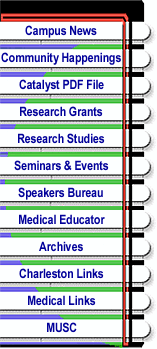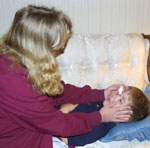
Return to Main Menu |
Eye
drops versus patch: the scientific verdict is in
Richard Saunders, M.D., professor of ophthalmology, had a key role in the
design of a study, the results of which were released Wednesday, March
13.
Atropine eye drops given once a day to treat amblyopia, or lazy eye,
the most common cause of visual impairment in children, work as well as
the standard treatment of patching one eye. This research finding may lead
to better compliance with treatment and improved quality of life in children
with this eye disorder. These results appear in the March issue of Archives
of Ophthalmology.
 Dr.
Richard Saunders Dr.
Richard Saunders
Saunders has been a proponent of using atropine in selected patients
for decades. He said he felt the treatment was clearly superior for certain
patients, but he was in a minority among pediatric ophthalmologists with
this view. He felt the design of the study was extremely important and
described his role on the executive committee that designed the study as
“one of two atropine advocates, making sure eye drop therapy got a fair
shake.” MUSC was one of 47 clinical sites throughout North America participating
in the study and had one patient enrolled.
After six months of treatment, researchers found that the drug atropine,
when placed in the unaffected eye once a day, works as well as eye patching
and may encourage better compliance. Compliance is an important factor
in the success of amblyopia therapy. Treatment should be started when the
child is young, since amblyopia is more effectively treated in children
under the age of 7. Timely and successful treatment for amblyopia in childhood
can prevent lifelong visual impairment.
“These results are important because they provide an effective alternative
treatment that helps prevent permanent vision impairment for children with
amblyopia,” said Paul A. Sieving, M.D., Ph.D., director of the National
Eye Institute, one of the federal government's National Institutes of Health
and the agency that sponsored the study.
 Seven-year-old
Mathew Tuk of Mount Pleasant participated at the Storm Eye Institute in
the national study. He was randomized into the atropine group and is pictured
with his mother, Kathy Tuk, as she prepares to give him his daily dose
of atropine eye drops. Seven-year-old
Mathew Tuk of Mount Pleasant participated at the Storm Eye Institute in
the national study. He was randomized into the atropine group and is pictured
with his mother, Kathy Tuk, as she prepares to give him his daily dose
of atropine eye drops.
“Amblyopia is currently treated by wearing an eye patch over one eye
for weeks to months. Children usually do not like this treatment approach
because of quality of life issues, such as irritation of the skin and teasing
by other children. This new study found that atropine eye drops had a higher
acceptance rate and better compliance by children and their parents than
did patching. This may well become a new standard treatment for some forms
of amblyopia,” Sieving said.
Amblyopia, or lazy eye, is a condition of poor vision in an otherwise
healthy eye because the brain has learned to favor the other eye. Although
the eye with amblyopia looks normal, there is interference with normal
visual processing, which limits the development of a portion of the brain
responsible for vision. The most common causes of amblyopia are misalignment
of the eyes (crossed eyes) or significant differences in refractive error,
such as farsightedness or nearsightedness, between the two eyes. Amblyopia
usually begins in infancy or childhood. It is estimated that as many as
three percent of children in the U.S. have some degree of vision impairment
due to amblyopia.
Treatment for amblyopia is most effective when started in young children
less than 7 years old. Response to treatment in older children is much
less effective. Most eye care professionals treat amblyopia by placing
an opaque adhesive patch, or “eye bandage,” on the skin to cover the unaffected
eye. This forces the child to use the eye with amblyopia, which stimulates
vision in the eye with amblyopia and helps the part of the brain that manages
vision to develop more completely.
However, many children do not like the appearance of the eye patch
and the accompanying social and psychological stigma and will not fully
cooperate, which can lead to treatment failure. Also, patching forces a
child to use an eye that has poor vision, often making compliance difficult
for active children. Unless it is successfully treated in early childhood,
amblyopia usually persists into adulthood, and is the most common cause
of monocular (one eye) visual impairment among children and young and middle-aged
adults. Consequently, it is crucial for children to comply with treatment.
The atropine eye drop works by temporarily blurring vision in the unaffected
eye, thereby forcing the eye with amblyopia to be used. This strengthens
it and improves vision. The advantage of atropine treatment is that
the parent simply places a drop in the child's eye once a day. With patching,
the parent must monitor the child wearing the patch for six or more hours
each day for many weeks or months.
In the Amblyopia Treatment Study, 215 children were randomly assigned
to receive patching, and 204 were assigned to receive atropine eye drops.
Researchers found that 79 percent of those receiving the eye patch were
treated successfully, and that 74 percent of those receiving the atropine
were treated successfully. This difference is clinically insignificant.
Although researchers found that vision in the amblyopic eye improved faster
in the patching group, the difference in the two
groups at six months was small and not significant.
“The daily burden to administer treatment for amblyopia falls on the
parent,” said study chairman Michael Repka, M.D., professor of ophthalmology
and pediatrics at the Wilmer Eye Institute of Johns Hopkins University
School of Medicine in Baltimore. “This study shows that one drop a day
of atropine works as well as patching the eye for some children with amblyopia.
Since both patching and atropine work equally well, the choice of treatment
can be made by the eye care professional in consultation with the parent.”
The children who were treated in this study will continue to be followed
until April 2003, allowing researchers to learn whether there is any longer
term advantage to treating amblyopia with either patching or atropine.
The study was conducted by the Pediatric Eye Disease Investigator Group
at 47 clinical sites throughout North America. The study was funded by
the National Eye Institute and coordinated by the Jaeb Center for Health
Research in Tampa, Florida and the Wilmer Eye Institute of Johns Hopkins
University in Baltimore.
|



 Dr.
Richard Saunders
Dr.
Richard Saunders